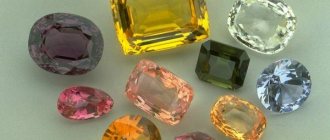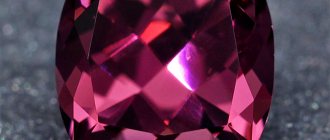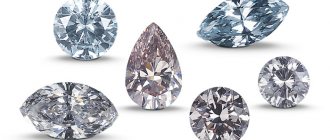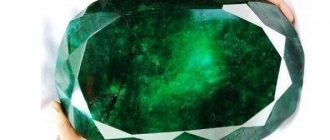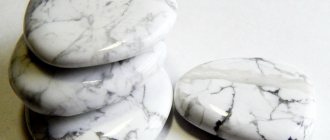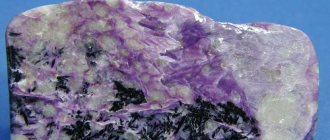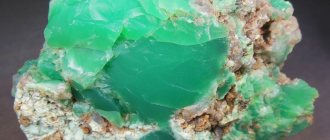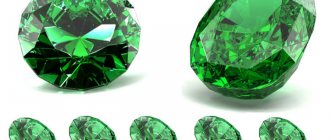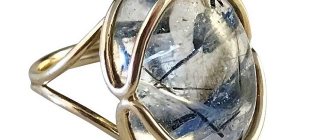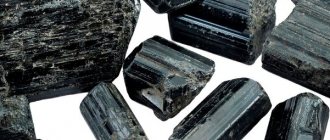When choosing jewelry with emeralds, rubies or other precious stones, you can almost always find the “GT” mark in the description. It means that the pebble insert is hydrothermal. But what is a hydrothermal gemstone, accessories, jewelry or jewelry?
The origin of the mineral is interesting, its reputation is impeccable.
Background
They tried to grow precious minerals two hundred years ago. The object of attention was ruby and emerald as the rarest, most beautiful and expensive.
The first hydrothermal emeralds of jewelry grade were obtained by the American Emily Flanigan at the dawn of the 1960s. However, the process died out before it was completed, and the crystals had to be transplanted into another “box” for growth.
Ten years later, Soviet scientists solved this problem. They achieved permanent, non-transplantation growth of emerald crystals from hydrothermal solutions. Today in Russia a technology has been developed that is also used to create other precious and semi-precious stones.
Hydrothermal gems
Paraiba in the works of Lydia Courtel
The world-famous French artist is called the guardian of the legacy of Rene Lalique. In her works, Lydia combines noble metals and the best gems that can only be found in the world. Paraiba tourmaline did not go unnoticed by her. She used it to create a jewelry collection dedicated to the inhabitants of the deep sea. The following illustration shows a Paraiba tourmaline ring created in the small workshop of Lydia Courtel.
In this workshop, which looks like a velvet-covered box, you can meet not only stage and film stars, but also famous designers. For example, Lagerfeld calls Lydia one of the best, so at many shows of his collections you can see her jewelry with Paraiba and other tourmalines.
Production technology
From the term “hydrothermal” it is clear that we are talking about water plus high temperature.
The technology for producing hydrothermal stones consists of crystallizing the substance from a hot aqueous solution at 650–700 °C and a pressure of 1500 atmospheres (1.5 Kbar).
Equipment
Hydrothermal stones are grown in an autoclave - a special vessel made of high-strength, corrosion-resistant steel. It is also called the growth chamber:
- A diaphragm - a hardened perforated plate - is fixed in the center. It serves as a separator between the “cold” and “hot” zones. This is the raw material dissolution zone (lower, under the separator) and the crystal growth zone (upper, above the separator).
- Seed plates are installed in the upper segment. They are carved from the natural stone they want to obtain. Crystals will grow on them.
Installation for growing from hydrothermal stones
Before the start of each cycle, the walls of the container are tested for defects: the slightest deviation causes an explosion.
Stages
The hydrothermal process includes the following steps:
- The raw material mixture is placed at the bottom - a substance that will dissolve. They are crushed precious or semi-precious minerals of non-jewelry grade. To create an emerald it is beryl.
- Then a mineralizer is added - the salt component of the aqueous solution. This is a mixture that increases the solubility of raw materials with a hydrothermal solution. Consists of the same elements as natural stone. Thus, vanadium and chromium are additives for emerald.
- The loaded autoclave is tightly closed at the top and fed into the oven. Heats up to 650–700 °C, experiencing a pressure of 1500 atmospheres (1.5 Kbar).
- The lower part gets hotter. The solution is saturated with the components of the charge, and thermal convection delivers its vapor to the growth zone.
- Here they cool, becoming supersaturated. Excess substance accumulates on the seed plates.
This is how crystal growth occurs.
Peculiarities
The peculiarity of the process is the variety and alternation of temperatures. The vessel is heated from below and cooled from above. This allows you to avoid the “underbaking” of individual sections of the future crystal and create agglomerates of the correct structure.
Four weeks later, the result is ready. The technology allows you to regulate the direction of growth, shape, and color of the crystal.
Interesting Facts
Quartz is a stone that has always been endowed with magical properties that can change a person’s destiny. Therefore, in museums you can see various artifacts made from it. Moreover, in most cases, single crystals were used.
The secret of processing quartz crystals was known to the Assyrians.
During excavations of Mayan cities, a skull made of crystal using laser technology was found. The age of the artifact exceeds two thousand years.
The quality of porcelain is determined by the purity of quartz sand, which, together with kaolin, is the basis for the production of porcelain charge. The first information about this is found in ancient Chinese historians.
To give amethysts a deep purple color, jewelers heat them to 600 – 700°C. It should be noted that the passport for the stone should contain information about this.
The largest unprocessed quartz crystal is on display in one of the St. Petersburg museums.
The Thai island of Koh Phangan, made of rose quartz, attracts yoga practitioners. This mineral is responsible for the heart chakra, so the most incredible transformations are possible on the island when performing yogic practices.
What stones are most often copied?
Hydrothermal treatment of stones is applicable to obtain many types of precious crystals. There are several in demand by jewelers:
- Emerald. It grows in a month and can have the desired green tint and glassy sheen. Also fragile, but without cracks, therefore more durable than natural. Indifferent to acids or high temperatures.
Emerald hydrothermal
Hydrothermal emerald is recognized as a full-fledged analogue of natural stone.
The technology developed by Soviet scientists from Novosibirsk is considered the best and commercially profitable. It is a de facto monopolist on the world market, displacing products obtained by other growing methods (Chinese, Biron, Malossi). Emeralds are sold under the brands Russian emerald (“Russian emeralds”) - cut stones of small fractions and Colombian color emerald (expensive large-sized processed specimens).
Table No. 1. Properties of hydrothermal emerald (grown).
| Formula | Be3Al2Si6O18 |
| Impurity | Fe2O3, V2O3, Cr2O3 |
| Color | Dark green, blue-green |
| Stroke color | White |
| Shine | Glass |
| Transparency | Transparent, translucent |
| Hardness | 7.5-8.0 on the Mohs scale |
| Cleavage | Imperfect |
| Kink | Conchoidal, uneven |
| Density | 2.69—2.78 g/cm³ |
| singonia | Hexagonal |
| Refractive index | nω = 1.564—1.595, nε = 1.568—1.602 |
- Citrine . Painting is done to order. Gloss and transparency at the highest level.
- Corundums . Hydrothermal rubies and sapphires are taken by the jewelry industry.
- Quartz . A popular jewelry imitation is amethyst. It is in demand due to its purity, degree of transparency, color saturation, and absence of internal defects. It is possible to distinguish hydrothermal amethyst from natural one only using special analyzers.
Quartz with specified parameters is also created for scientific, research, and industrial needs.
Considering the temperature and pressure parameters, it is impossible to create a crystal at home using the hydrothermal method.
The quality of the final product is indicated by the following fact. In Germany, such crystals are not called hydrothermal, synthetic or artificial, but cultural.
Variegated mix
Astrologer Nazarova writes that tourmaline belongs to the group of warrior stones (together with fluorite, pyrite, spinel).
All the beauty of tourmalines is most clearly revealed in daylight. Artificial and evening light extinguishes the beauty and shine of tourmaline.
The most valuable type of mineral is Paraiba Tourmaline.
While searching for mica in the state of Minas Gerais (Brazil), tourmaline deposits were discovered. You don't always find what you're looking for.
The color intensity of tourmalines is valued only up to a certain optimal limit. Above this limit their value decreases.
The famous astrologer T. Macia advises decorating with sherlom rooms where it is necessary to limit excessive frivolity and sensuality.
According to G. Smith, red tourmaline, having been exposed to daylight for about a hundred years, noticeably turns yellow.
The Indians believed that watermelon tourmalines enhance a person's sexual abilities and kindle the passion of love. Therefore, men wore these stones with pleasure. But watermelon tourmaline was prohibited for women. A woman's love will create problems for her man...
Fake or not?
Hydrothermal stone does not mean fake in the standard sense.
The duality of the nature of stone
This is an intermediate stage between natural material and synthetics:
- Synthetic because it is grown in a laboratory at an accelerated pace. Natural stone takes millions of years to form, laboratory stone takes a month and a half.
- It differs from synthetic in composition. The raw materials of hydrothermal crystals are the components that make up natural stone. Therefore, their crystal lattice and chemical formula are identical.
Only a gemologist using special equipment can determine whether a stone is hydrothermal or natural.
Signs of a grown sample
Under a powerful microscope and spectroscope, a laboratory sample looks like this:
- Has inclusions - tubes or gas bubbles formed by air trapped during manufacturing.
- Brownish iron oxide impurities are visible: they come from the walls of the autoclave. This does not happen with natural stones.
- Endowed with an ideal structure. Cracks, irregularities, darkening, inclusions inherent in natural minerals are absent here.
- It has curvilinear zoning created during crystal growth. This phenomenon has not been observed in natural sapphires or rubies.
Synthetic stones in jewelry are almost always more beautiful than natural ones.
Synthesis of emeralds
Application
Jewelers prefer working with hydrothermal stones over natural ones, since it is difficult to find a gem without flaws, inclusions, small cracks, which complicate the processing process, narrow the possibilities of cutting, and it is even more difficult to find the right size and color.
Synthesized minerals successfully inlay gold and silver jewelry: earrings, necklaces, rings, rings, tiaras. Used in the manufacture of watches, cufflinks, tie clips, jewelry boxes, and figurines.
Hydrothermal stones are used in the space industry, electronics, medicine, for the creation and production of complex microcircuits and mechanisms.
How to care for jewelry
Hydrothermal stones are the same crystals as natural ones, so their care is similar:
- Give large accessories a personal soft box from the inside, and small ones (such as rings or earrings) a compartment in a common box so that they don’t interfere with each other.
- Remove jewelry before household work, cosmetic and water treatments.
- It is advisable to wipe the stones with a soft cloth to remove sweat and dust after each use.
- Clean regularly with warm soapy water.
- If the jewelry is in a frame, the solution for cleaning it should not get on the stone.
If the stone is used as a magical talisman, it is cleaned of negative energy with running water.
Treasures of the Brazilian Hills
The first of them is associated with the day when a person first picked up a paraiba nugget. This happened in the early 80s of the twentieth century in a remote Brazilian province. A certain Eimas Barbosa arrived there with a company of like-minded people - dreamers like himself. They spent about five years searching for the treasure to no avail. But the seekers did not lose hope, and Barbosa himself unconditionally believed that his dream would someday come true. But the researcher was never able to see the result with his own eyes, not living long before the triumphant discovery.
However, his dream did come true. The reward for hard work and faith was the discovery of a deposit of unique tourmalines, which had a deep blue hue, excellent strength, fairly large size and amazing purity. Paraiba tourmaline gets its name from the place where it was first mined. That same province in Brazil was called (and is still called) by the same name. Since then, it is believed that Paraiba gives the owner the ability to recognize secrets and find lost or hidden things.
Magic properties
The magical and healing properties of hydrothermal stones have not been precisely studied; the esoteric community does not have a single point of view:
- Some argue that since the base of the mineral is natural, the magic of the stone will work. Although not as effective, because it is grown quickly.
- The majority is sure: since it has not absorbed the energy of the Cosmos and the Earth, it means it has no power.
As always, it's a double-edged sword. If there are no magical properties, then hydrothermal, for example, emeralds can be worn by everyone, not just those born in May.
It’s even easier with alexandrites. Natural ones are considered “widow’s stones” and require compliance with rules when worn. For hydrothermal this is not necessary.
However, such a pebble will not harm anyone as a talisman. Especially if a person has empathy with him on a subconscious level. That is, wearing jewelry or holding a pebble in your hands is simply pleasant.
Who is it suitable for?
- Actors.
- Pupils and students.
- To inventors.
Expert opinion
Semenishcheva Polina
Specialist in mineralogy. Graduated from St. Petersburg Mining University.
Attention : Sherls help you lose excess weight. However, lithotherapists do not recommend wearing them.
Zodiac signs
Tourmaline is suitable for many zodiac signs. The main thing is to choose the right variety.
Sherls are astrologically suitable for Gemini in the second decade.
Green and red gems are suitable for Sagittarius of the second decade.
Watermelon tourmaline is ideal for Aquarius of the 1st decade.
Other representatives of the star circle can wear tourmaline jewelry without harm and be treated with the gem.
Is Tourmaline right for you?
Not really
Element
All elements (Earth, Water, Air, Fire). Depends on the type of gem.
Planets
Pluto
Venus
Energy
Depends on the variety. Either Yang or Yin. In polychromes both types of energies are present.
